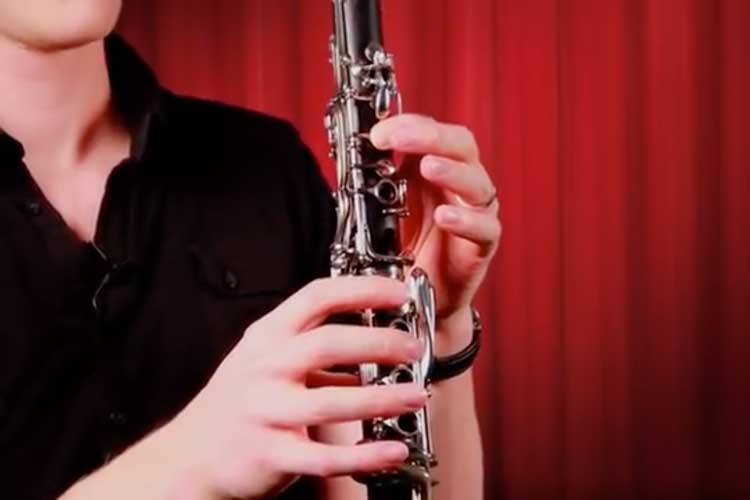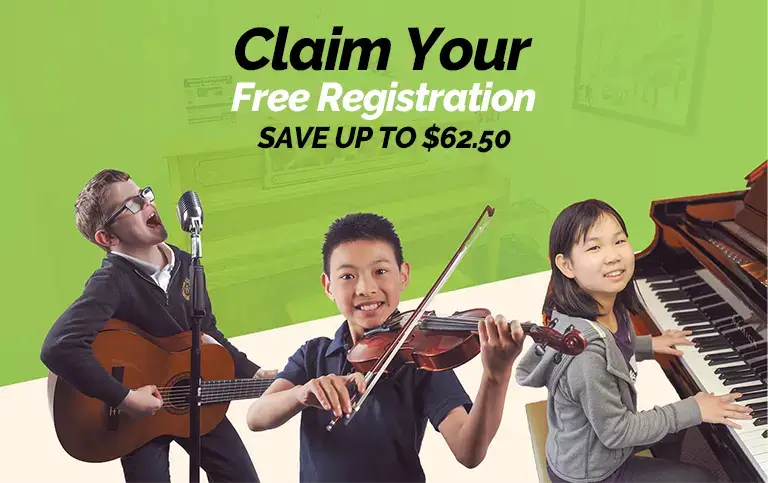The most promising way to learn to play the clarinet is by taking private lessons from a qualified and experienced clarinet teacher, like the clarinet teachers at the Mississauga Fine Arts Academy, the most awarded and highest-rated music schools in Ontario.
If you are looking for a music school nearby to take private clarinet lessons but have some questions of your own, let us help you answer some of the most common questions we get from our students and parents.

Award Winning
Clarinet Lessons in Mississauga
Learn to play the clarinet at home and in-school

Table of Contents
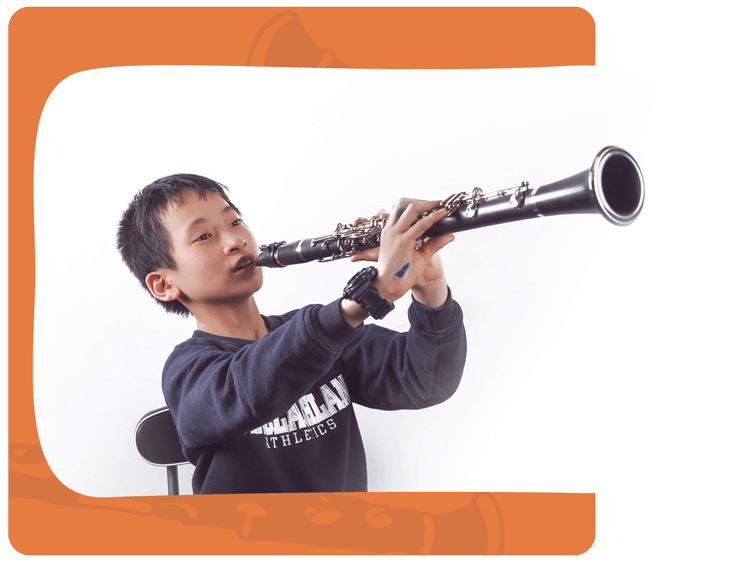
Most Awarded Music School
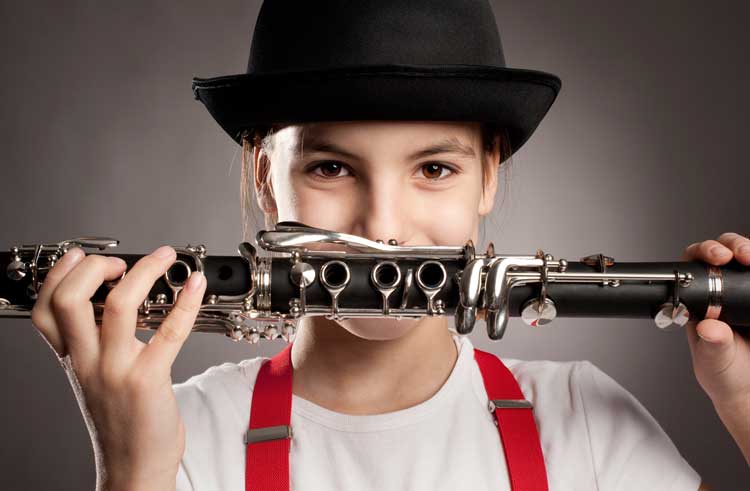
Your Questions, Answered
Is the clarinet easy to learn?
It's not difficult to learn to play the clarinet. It might be even easier than any other instrument. If you have an interest, if you have a desire, if you are determined to learn to play the clarinet, and if you find the right music teacher, you will definitely succeed. Reach for your dreams, don’t sit on the sidelines. The reward and joy you will get from playing the clarinet and surrounding yourself with music are priceless.
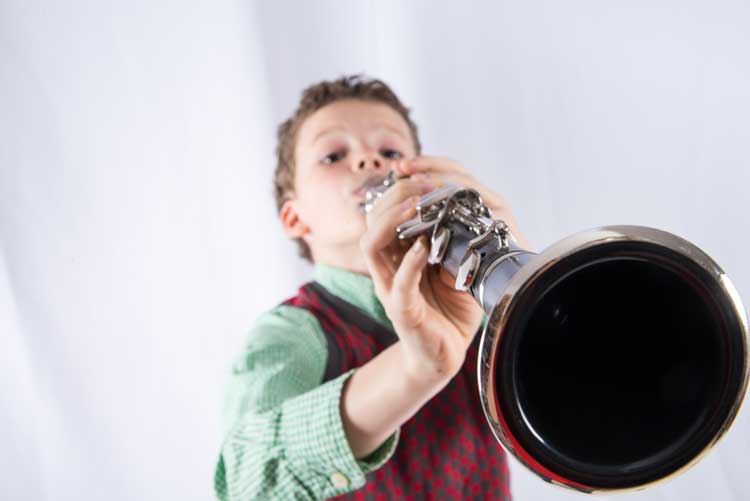
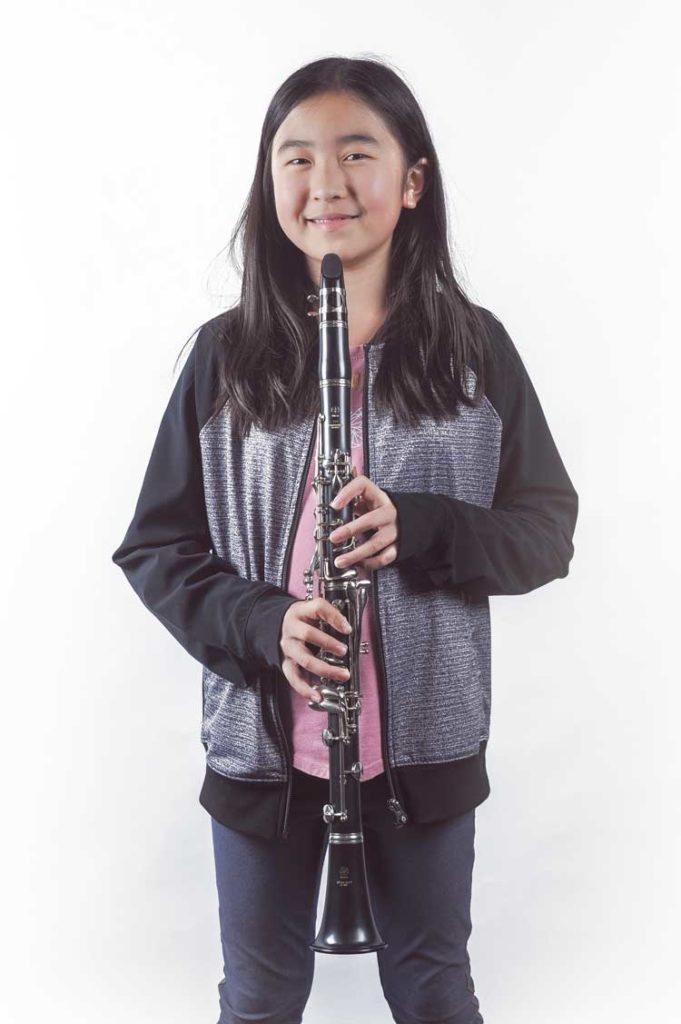
Can you teach yourself to play the clarinet on your own?
You could try learning on your own but the fact is that learning clarinet by yourself takes much longer and it is much more difficult to learn without the guidance and instructions from an experienced, qualified, and passionate clarinet teacher. Our teachers have vast teaching experience and many teaching methods that have already been tried and proven very successful.
Our music school offers in-person clarinet classes and online classes. The curriculum starts from a beginner level and up. If you already have some experience with any of the woodwind or brass instruments it will be very easy to learn to play the clarinet. You will progress to advanced level classes in no time. Our clarinet instructors will encourage your growth, help you overcome stage fright, accommodate your personal learning style, and will work with you to help you accomplish your goals. Your success is our greatest accomplishment.
Can children learn to play the clarinet? When it's best to begin clarinet lessons?
Yes, most definitely kids can learn to play the clarinet! Even if the child is as young as 7 or 8 years old, and if the child is interested in music, able to focus his/her attention, and really wants to learn to play a musical instrument, the clarinet is a great option.
There are smaller types of instruments that can be easily held and played by children. Adding a strap around the child’s neck, a strap that attaches to the instrument will help with carrying the weight of the instrument while playing. Your child’s teacher will be able to make suggestions on the best clarinet type and help you decide what is best for your child.
The clarinet is very easy to carry around. You could rent an instrument before making a decision and purchasing one.
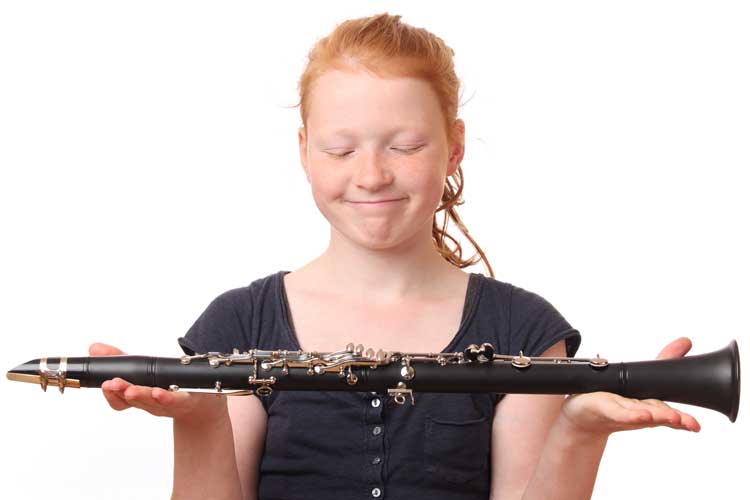
What Is A Clarinet?
The clarinet (French “clarinette”) belongs to the woodwind category of instruments.
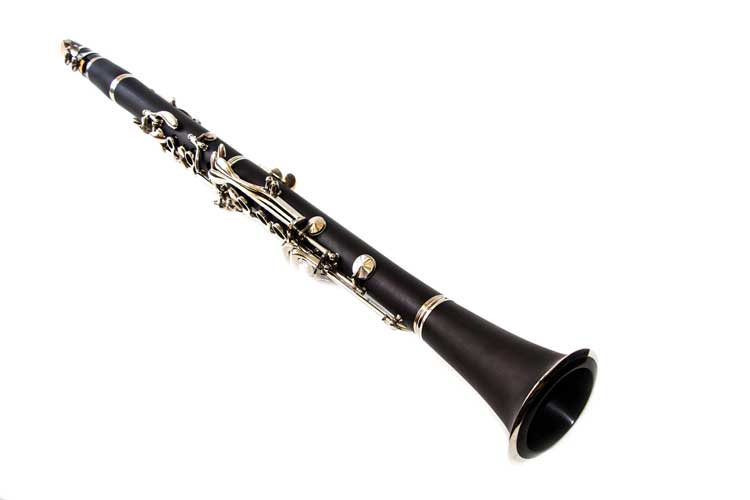
The clarinet has a single-reed mouthpiece usually made of ebonite, a type of hard rubber. The reed inside the mouthpiece is usually made from natural cane. The reed comes in different strengths (thickness). The thinner reeds have less resistance and are more suitable for beginners who are learning how to get the sound out from the clarinet. The thicker the reed the better the tone and the ability to reach higher notes. Students use 1.5 strength and professionals may use 4 and higher strengths.
The clarinet’s body is in the shape of a long cylindrical tube, around 26 inches (66cm) long, with a flared bell at its end. The cylindrical bore gives the clarinet its distinctive timbre and sound. The body of the clarinet is traditionally made of African Blackwood, and this is the type of instrument most professional clarinetists use. Nowadays you could find cheaper clarinets made of other types of materials including other types of wood (boxwood), plastic, resin, metal, hard rubber, and ivory. Student clarinets are usually made of resin.
The clarinet is tuned in B♭, and its notes (made with the finger holes and the key mechanism) sound a step lower than what they are written. There are 17 keys on a standard clarinet. Some of the keys have more than one function. The clarinet also has an octave key which enables the clarinetist to play higher notes.
History Of The Clarinet
The clarinet has its roots in the many folk single-reed instruments in Ancient Egypt, Ancient Greece, the Middle East, and Europe. Most notably from the Baroque woodwind instrument called “chalumeau”, an instrument similar to a recorder but with a single-reed mouthpiece and cylindrical bore.

The clarinet’s first development and its invention are attributed to the German woodwind instrument maker Johann Christoph Denner and his son Jacob Denner, in early 18th century Europe. They changed the chalumeau by converting one of its keys into a register, allowing it to play well in the middle register, producing loud and shrill sound, leading to its name “clarinetto” (little trumpet). This instrument was played with the reed up.
By shortening the bell and elongating the body of the early clarinet the addition of lower and upper keynotes was accomplished. By the late 1800s, the clarinet had five or six keys and various pitches. It was widely used in orchestral music.
The more modern clarinet developed in the first half of the 19th century. This development included adding more keys, keywork mounted on pillars, enlarging the bore and the mouthpiece, and the invention of the modern air-tight pads for the tone holes by Iwan Muller.
Theobald Boehm introduced the keyrings and Auguste Buffet the needle springs. These two, Boehm and Buffet, represent the two modern systems of keys and holes arrangements, still standard in many countries. Its distinguishing features are the ring at the back for the thumb and the multiple keys for the right little finger.
The Albert “simple” system, named after the clarinet developer Eugene Albert. Used in German-speaking countries this system is characterized by the gradual addition of keys and conservative features in bore, mouthpiece, and reed, allowing for deeper tone quality to the instrument. The Oehler system and the Reform Boehm system are the other two known systems.
Types Of Clarinets
There are several families of differently pitched clarinets, here are some of them:
- Piccolo clarinet - A♭key, a rare clarinet used in contemporary and military music
- Sopranino clarinet in E♭- E♭clarinet, used in classical orchestras
- Sopranino clarinet in D - D clarinet, rarely used, mostly in classical orchestras
- Soprano clarinet in C - C clarinet, very common at the early times of the clarinet
- Soprano clarinet in B♭- B♭clarinet, the most common type used in all genres
- Soprano clarinet in A - A clarinet, used in orchestral and chamber music
- Basset clarinet - A extended to C clarinet, and B♭, used in classical music
- Basset horn - pitched in F, extended to low C, characterized by a narrower bore
- Alto (tenor) clarinet - pitched E♭or F, with greater size and lower pitch, used in chamber music and concert bands
- Bass clarinet - pitched B♭or A, used in contemporary music, concert bands, and jazz
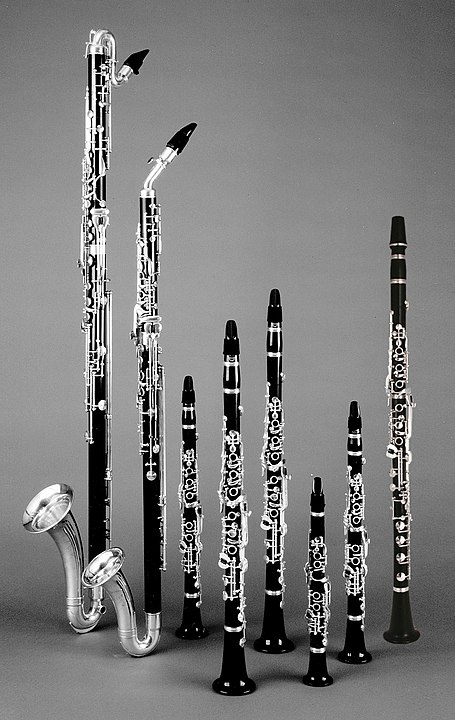
Bass clarinet, Basset horn, clarinets in D, B♭, A, high G and E♭, basset clarinet in A
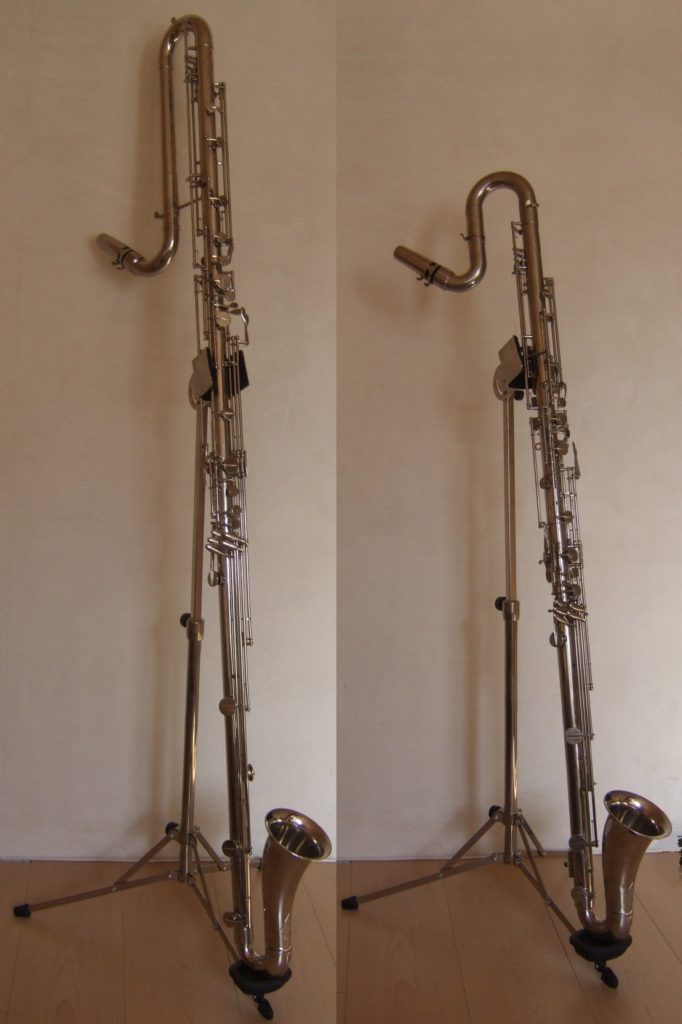
- E♭Contrabass (contralto) clarinet - key EE♭, used in concert bands and choirs
- Contrabass (double-bass) clarinet - key BB♭, used in concert bands and choirs
How To Play The Clarinet
- Sit on a sturdy chair, with good posture, head up and your back straight, feet firmly planted to the ground.
- The clarinet should be held at a 45-degree angle away from your body.
- Bring the instrument to your mouth, not the other way around.
- Hold the clarinet with your right hand on the bottom part, with your right thumb on the back of the instrument. The three right-hand fingers should hover over the bottom corresponding keyholes.
- The left hand should hold the top part of the clarinet, your left thumb should rest on the octave key at the back of the instrument. The other three fingers should rest over the three main keys at the top part of the instrument.
- Wet the reed before playing the instrument so it doesn’t sound squeaky when you play
- Make a shape with your mouth, kind of like you just tasted a lemon, this shape is called embouchure.
- Bring the mouthpiece to your mouth and seal the corners of your mouth around the mouthpiece
- Blow into the instrument to make a sound
- Keep your cheeks tight
- Push down different keys to experiment with a few notes
- Sign up for private lessons at the Mississauga Fine Arts Academy!
Clarinet’s Usage and Repertoire
The earliest known repertoire for the clarinet was published in 1716 by Estienne Roger in Amsterdam. The first clarinets had only two keys. With further development by the year 1780, the clarinets had five to six keys and were used in orchestral music. Sometimes multiple clarinets were playing different keys in the orchestra.
Here are some of the well known classical composers and repertoire for the clarinet:
W.A. Mozart - Clarinet Concerto in A major, K. 622
A. Copland - Clarinet Concerto
C.M.v. Weber - Clarinet Concerto No.1 and No.2
J. Brahms - Clarinet Sonata No. 2 in E flat
G. Gershwin - Rhapsody in Blue
C. Debussy - Premiere Rhapsodie
D. Shostakovich - Symphony No. 5
Famous Classical Clarinetists
Well-known classical clarinetists include:
1753 - 1846
Anton Stadler
a famous clarinetist who inspired Mozart to compose his compositions for the clarinet
1778 - 1846
Johann Simon Hermstedt
was a clarinet virtuoso who also inspired composers to write many clarinet compositions
1784 - 1847
Heinrich Baermann
clarinetist who inspired Weber’s Clarinet Concertos
1811 - 1885
Carl Baermann
the son of Heinrich Baermann, who was also a famous clarinetist and also known as a professor and a writer of many clarinet books
1856 - 1907
Richard Mühlfeld
clarinetist whose sweet tone inspired Brahms’ clarinet compositions
1915 - 2003
John (Jack) Brymer
a leading English clarinetist in his time
Born 1937
Karl Leister
German classical clarinet player
Born 1942
Richard Stoltzman
American classical and jazz clarinetist
Born 1949
James Campbell
American-Canadian classical and contemporary clarinetist
Born 1959
Sabine Meyer
Germany’s most popular clarinetist
Born 1971
Sharon Kam
classical German-Israeli clarinetist
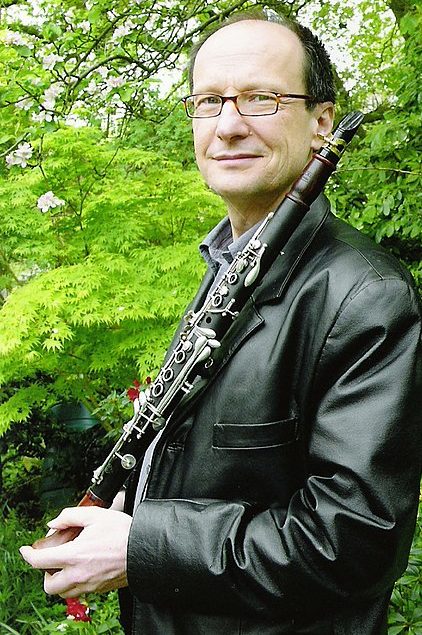
American-Canadian clarinetist James Campbell
Sabine Meyer Mozart’s Clarinet Concerto in A major, K. 622 with clarinet solo:
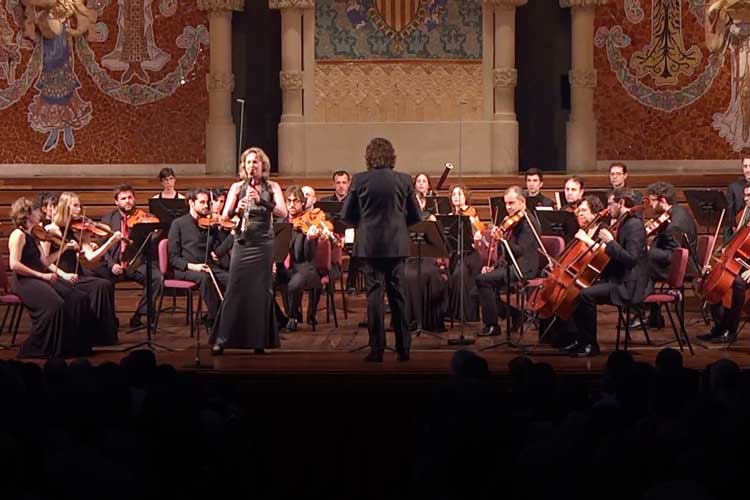
Famous Jazz and Swing Clarinetists
Benny Goodman
American jazz clarinetist and a bandleader, known as the ”King of Swing”
Eric Dolphy
Multi-instrumentalist, played bass clarinet and piccolo
Pete Fountain
an American jazz clarinetist, played traditional Dixieland jazz
Phil Nimmons
Canadian jazz clarinetist
The clarinet is also used in chamber music and other genres like pop, rock, military and marching bands, Klezmer-Gypsy-Tango orchestras, and Big Band/Jazz ensembles.
Reasons Why You Should Learn To Play The Clarinet
Learning to play any instrument has been proven to be beneficial in many ways. The clarinet is no exception. Some of the benefits include:
- The clarinet is a great instrument of choice for beginners and children due to it being easy to handle and grasp its fundamentals quickly
- Playing the clarinet helps with the development of coordination and motor skills
- It helps the player develop and improve cognitive functions of the brain leading to better memory, decision making, reasoning, retaining information, and academic success
- The clarinet is a versatile instrument, frequently being a part of school bands and music programs, and it's used in many different genres
- If you learn the clarinet it is very easy to learn to play the saxophone and other woodwind instruments
- The clarinet is a very affordable and portable instrument
- There are several types of clarinet players can choose from
- There is a great social and mental health benefit associated with playing an instrument like the clarinet
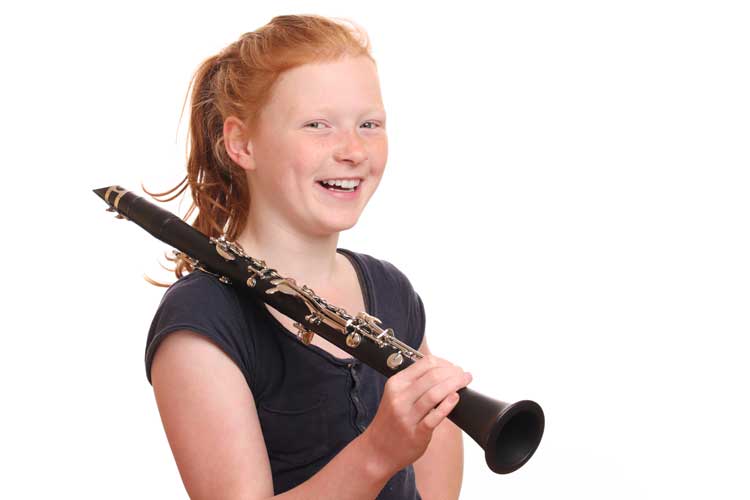
There is documented evidence that proves the many benefits of taking music lessons and learning to play musical instruments like the clarinet. It is great for your mind, body, and spirit, the whole person. This is why you shouldn't delay your music journey and sign up for a music lesson.
Instruments We Teach & Tuition
Our Academy of Music provides the highest quality saxophone lessons as well as many other different types of private music lessons. Our music school has a wide selection of teachers. And to accommodate your busy schedules and lesson preferences, we provide private in class music lessons in Mississauga, Ontario (Peel Region) and online lessons, including:
- Piano lessons
- Classical Guitar lessons,
- Bass lessons, and Ukulele lessons
- Voice lessons and Harmony lessons
- Violin lessons and Cello lessons
- Drum lessons
- Saxophone lessons, Clarinet lessons, and Flute lessons
- Brass instrument lessons including Trumpet lessons
- Music Theory lessons and Music History lessons
Our current lesson rate is $37.50 per 30-minute private clarinet lesson.
Lessons are scheduled once a week and available seven days a week. There is a one-time registration fee of $25.00. No prior musical experience is required to start any of these lessons.
Our students come from all of the Peel Region including Brampton, Caledon, also from Milton, Oakville, Etobicoke, Toronto, and all over Ontario and Canada, through our online lessons.
This speaks volumes about the quality of music education our Academy offers to our students. Our students participate in many recitals, annual concerts, and music festivals in the GTA.
Come to the Academy for your lessons and start enjoying all the benefits of learning music has to offer. You will instantly become part of our wonderful music family

